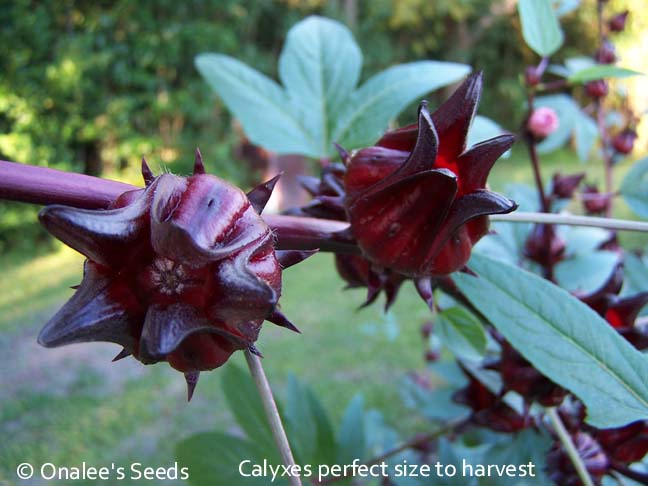|
Onalee's Home Grown Seeds & Plants
Click
the BACK button to go back to the product |
|
Recipes for:
Roselle Hibiscus,
Rosella, Florida Cranberry, Australian Jam Fruit, Jamaican Sorrel |
 |
There are as many recipes for preparing the calyces of the
Roselle Hibiscus as there are people that prepare them, but here are
some basics and some links to other sites with more ideas.
First, the calyces should be harvested when they are easy to snap
off the bush (they are about the size of a quarter or slightly
larger around the base), this is about 10 -15 days after the bloom fades. If
you have to cut them off with clippers, you've waited too long.
This really just takes trial and error and you can still use the
older ones. From my experience, the older they get the less pectin
they have in them and they get more tart (which isn't necessarily a
bad thing depending on your taste).

After harvesting them, I remove the green seed pod from the
bottom by cutting along the base of the calyx and splitting the side
and pulling the whole green pod out. In some recipes, they say
that it's not necessary to remove the seed pods but if you're making
jams or anything that leaves the fruit in the end product, you will
need to remove the seed pod.
After washing the calyces, you are ready to go! Here are some
recipes, adjust them to your taste (especially the sugar content),
you can also make them stronger or weaker based on how many calyces
you use and how long you cook them (longer cooking = stronger
Rosella flavor).
Good luck and have fun!
Tea:
For a Quart of Iced
Rosella Tea:
- Place 16-18 calyces (seeds removed) in
saucepan with 1 pint of water, bring to a boil.
- Boil for about 3 minutes until the water
turns dark red
- Turn heat off and allow to set for an
additional 3 minutes
- Pour into a quart jar, straining the calyces
out
- Add sugar to taste (about 3-4 teaspoons) and
stir until sugar dissolves
- Add Ice Cubes until jar is 3/4 full
- Check for flavor, if too strong, add more
water and/or sugar
For a cup of Hot Herbal Rosella Tea:
- Place 5-6 calyces (seeds removed) in saucepan
with 1 cup of water, bring to a boil.
- Boil for about 3 minutes until the water
turns dark red
- Turn heat off and allow to set for an
additional 3 minutes
- Pour into a cup, straining the calyces out
- Add sugar to taste and stir until sugar
dissolves
- Check for flavor, if too strong, add more
water and/or sugar
Alternative for Hot Herbal Rosella Tea:
- Place 5-6 calyces (seeds removed) in a mug or
coffee cup
- In saucepan, bring 1 cup of water to a boil.
- Pour boiling water into cup over calyces and
allow to set for 3 minutes
- Add sugar to taste and stir until sugar
dissolves
- Check for flavor, if too strong, add more
water and/or sugar
Jam:
- Prepare the fruit for jam
making first soak it for a few minutes in a sink full of cold
water and then drain.
- Separate the red calyx (the
fleshy red cover surrounding the seedpod) from the seedpod. An
easy way to do this is using an apple corer pushed hard against
the base of the calyx; the calyx will then separate from the
seedpod.
- Put the red calyx into a bowl
and the seedpods into a saucepan.
- Cover the seedpods with water
and simmer for 10 minutes, until soft and translucent in
appearance.
- Strain the seedpods through a
sieve and dispose of the seedpods, reserving the liquid. This
process extracts pectin from the seedpods to help the jam set.
- Pour the liquid back into a
large saucepan, add the red calyx and simmer gently until they
are very soft.
- Measure this fruit pulp and
add cup for cup of sugar to fruit.
- Stir over a gentle heat until
the sugar is completely dissolved and then bring to a boil. The
jam will froth high in the saucepan and so needs to be no more
than half full before you start it boiling.
- Test for setting by putting an
empty saucer in the freezer to chill, then put a teaspoonful of
jam on the saucer, wait for it to cool slightly and then push
the top of it with your finger. If it crinkles it is cooked.
Another sign that it is setting to watch for is when the jam
stops frothing and settles down to a hard boil.
- As the jam reaches setting
point it is also most likely to stick and burn so pay close
attention and stir often. Remember that the setting of a jam is
a chemical reaction between the fruit acid, the sugar and the
pectin, not an evaporative process. Jams set as they cool, if
over-cooked the setting point may be passed and instead a thick
syrup rather than a gel is formed.
- Bottle the jam into clean hot
jars and seal immediately.
Other links:
Here are some other sites with recipes for Rosella - keep in mind
that SOME sites may be referencing DRIED Rosella calyces and you
will have to adjust the weight/amount you use if you're using FRESH
calyces. Also keep in mind that some sites call the calyces FLOWERS
or "flor de Jamaica", these are not the flowers, but the calyces,
they are referring to.
Roselle Jam and Jelly from the University of Northern Texas
Rosella Jam
Hibiscus Sabdariffa Recipes
Agua de Jamaica
If you have a
WONDERFUL recipe for the Rosella that you've used with success and
would like to share it with everyone, email it to me, I'll be glad
to post it!
|